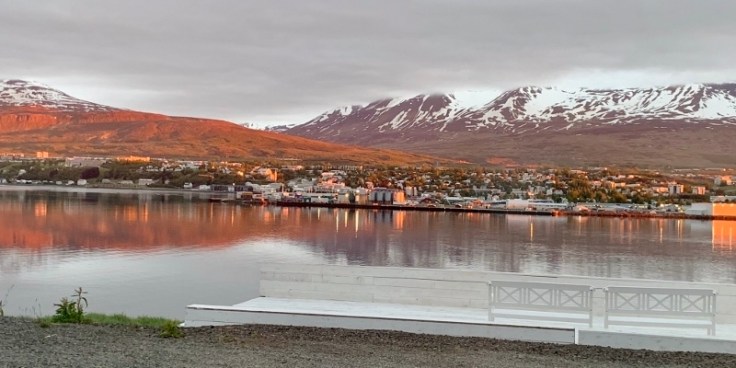
The owner of the apartment took us outside to show us the hot tub. Wind-whipped strands of blonde hair were dueling across her face as she spoke. Each evening, she said, she would turn on the tap and hot (38C) geothermal water would flow from underground into the tub. Our private Blue Lagoon.
We were in Iceland’s northern city of Akureyri, 20 nautical miles (40 kms) south of the Arctic Circle, and half way through our two-week road trip. I was continually being blown away – in every way – by the meteorological, topographical and geological wonders and anomalies of this tiny island in the middle of the North Atlantic Ocean.
As the owner turned to leave, I had one last question: “Is it always this windy here?”
“What wind?” she replied, without a hint of humour. “What, this?” She swept her hand over the grey waters at the base of the Eyjafjordur Fjord and shrugged.
“This is normal.”
I had checked the weather forecast for these first two weeks of June, and daily highs across the walnut-shaped country ranged from 9C in the south to 12C in the north. Like other first-time tourists, we were advised to dress in layers and be prepared for unpredictable weather. But no one mentioned the wind.
Iceland is considered the second windiest country in the world, based on windy days a year. This volcanic, almost treeless, island is surrounded by three oceans with currents that produce multi-directional winds.
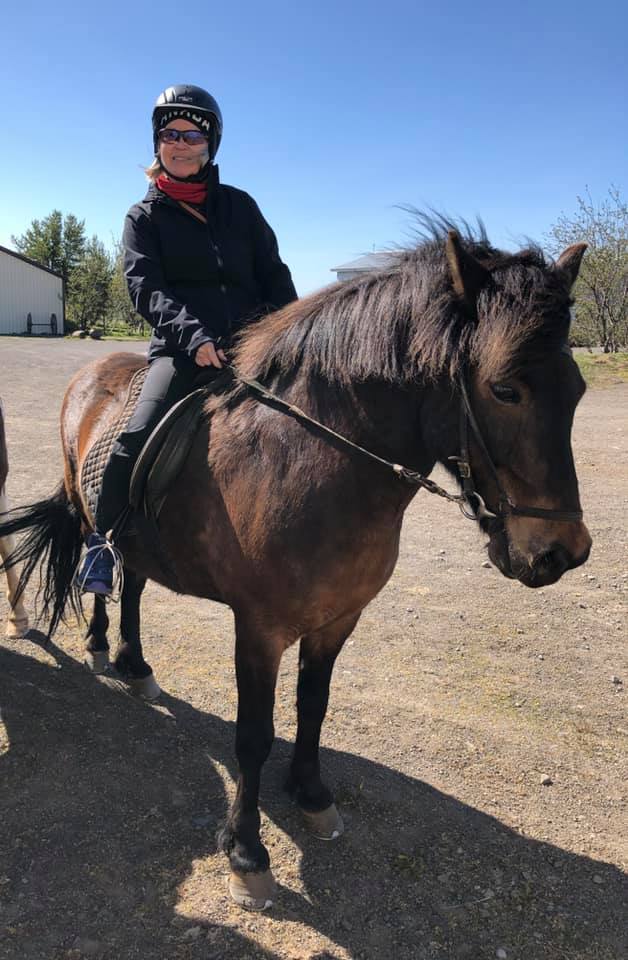
We hired a tour guide for our first two days in Reykjavik to see some of the most popular attractions in the south. Then we drove to the extreme northwest to the less-visited Westfjords. We picked up the Ring Road (Route 1) again in North Iceland, stopping for the night at Gauksmyri Lodge to ride the world’s purest bred, five-gaited Icelandic horse.
Tomorrow, from our new base in Akureryi, we would go whale watching in Husavik. Then we would continue on Route 1 to East Iceland, where we would visit a colony of 10,000 pairs of nesting puffins, before flying back to the capital.
The Blue Lagoon
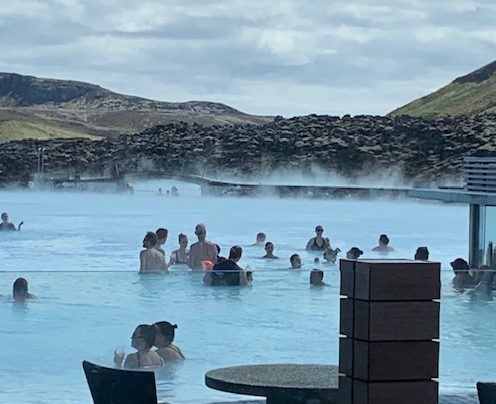
Our first stop when we landed was the famous Blue Lagoon, 20 minutes south of the airport. We had pre-booked (this you must) our bathe in the mineral-rich 30C (85F) geothermal waters. By 10:30 a.m. we were sipping Prosecco from a poolside bar while smearing our faces first, with a fine white silica mask, and then with a green algae mask, scooped from communal pails at poolside stands. How I wish I had my camera to capture our comical faces floating above the aqua blue water.
Along the Golden Circle
The next morning we headed 100 km northwest to see our first of many dramatic waterfalls. The Gullfoss Waterfall is the largest volume waterfall in Europe. The wind along the narrow path beside the two-tiered falls was bracing and some folks were hanging onto their hats instead of capturing the rainbow when the sun reappeared. I was the first to retreat to the warm vehicle, where our guide waited.
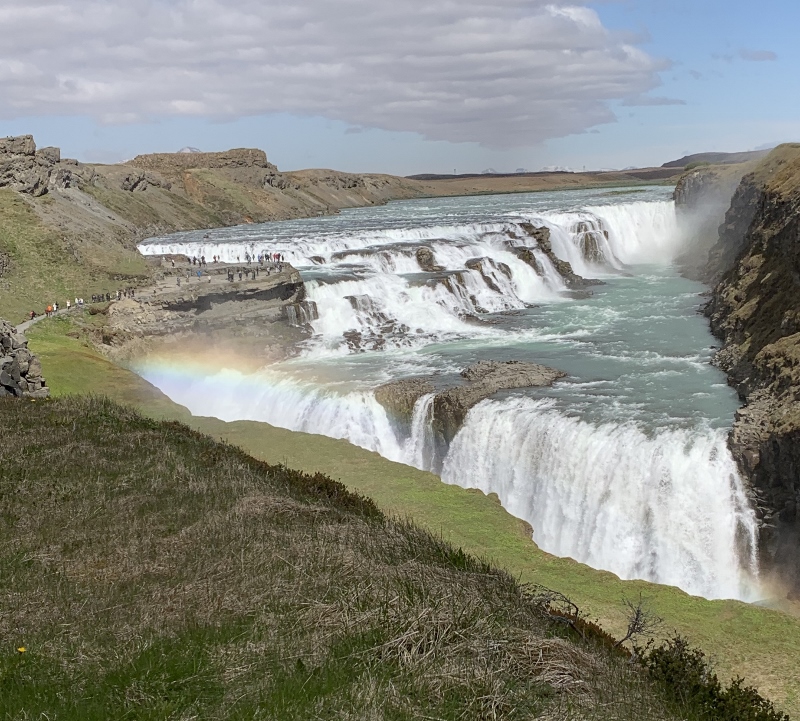
“Is it always this cold?” I asked, unzipping my waterproof jacket and fleece and removing my woolen toque, sunglasses and gloves.
“Cold?” he deadpanned. “The sun is shining. This is a nice summer day.”
I turned to look at him — in his white long-sleeved cotton shirt and black sleeveless vest — and saw he was having fun with me. With 2.3 million visitors in 2018 to this island of 350,000 residents, he was used to questions about the weather.
“In the North, where you are going, it will be warmer and sunnier and less windy than here in the South.”
I raise my eyebrows. “The closer we get to the Arctic Circle, the warmer it will be?”
“It’s true,” he laughed. “In the summer, the South is cooler and wetter than the North.”
It’s the mixing of the warm Atlantic Gulf Stream with the cold Arctic currents that creates unstable weather in the southwest. The north is the sunniest and the driest. The Westfjords is the coldest.
We arrived 10 minutes later at the 1,000-year-old Geysir Geothermal Area and walked past bubbling hot mud holes and blowholes to the active Strokkur. The original dormant Geysir, after which other geysers are named, used to spout 70 m (230 ft.).
We joined other visitors in a wide circle around the geyser, which spouts up to 30 m (100 ft.) every 5-10 minutes. The wind was steady as we waited with our cameras, watching the steam bubbles rise to the surface and begin to erupt.
Suddenly a strong gust blew the 20 m high, sulfur-tinged, hot steam into the faces of everyone standing downwind. (Where is downwind when the wind keeps changing direction?) My camera’s video recorded me gasping as I disappear into the hot steam vapours.
Walking on the Ocean Floor

After lunch we visited the Thingvellir National Park, a UNESCO World Heritage Site, to experience a natural phenomenon found only in Iceland. We walked along a seafloor ridge that separates the North American and Eurasian continents.
This Mid-Atlantic Ridge is the boundary between the two continents’ tectonic plates and runs beneath Iceland. Twenty million years ago, the island was formed by volcanic eruptions along this ocean floor mountain range.
The ridge continues to widen as the tectonic plates slowly drift apart (2.5 cm or 1 in. a year) creating a 70 m wide rift valley. In Iceland, a segment of this ocean floor ridge has risen about 1-2 km above sea level, allowing us to walk in the rift valley between two continents.
The Wild Westjfords
Iceland’s scenery is as breathtaking and changeable as the wind and as pure as the cold water flowing beneath our feet. The landscape shifts from plains of dark lava rock, spewing geysers and steamy hot springs in the South to snow-capped volcanic cones and glaciers in the Highland Interior, to farmland pastures of grazing black and white sheep, to the snow-covered, flat-top mountains that plunge into the cold blue sea in the northernmost Westfjords.

We tunnelled our way through the mountains and wound our car around the coastline fingers of the fjords to Isafjordur, a small fishing village from the 1700s.
The remote northwest region is only drivable in the summer months, but the stark beauty of the glacier-carved fjords, the friendly locals and delicious fish dinners make the side trip so rewarding.

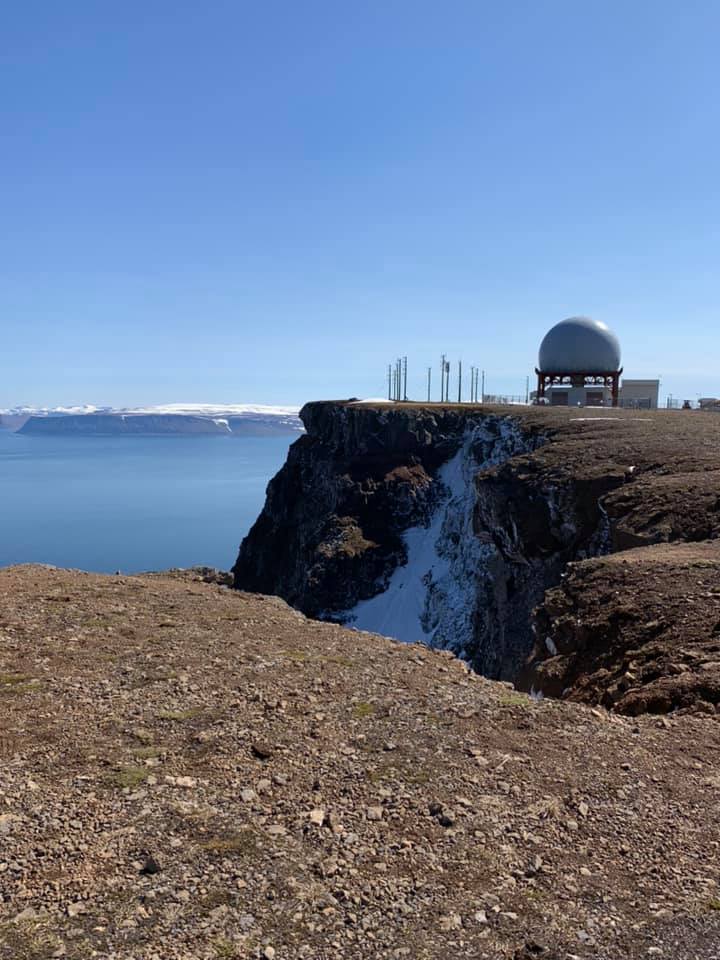

The next morning we drive the winding gravel road up to the summit of the Bolafjall mountain, a sheer 634 m (2,080 ft) drop to the sea below. If it was too windy, this steep, narrow road would be closed. Walking along the plateau we see an old US radar station now used by the Icelandic Coast Guard.
Strong wind gusts tore tears from my eyes as we walked across the street to a restaurant for dinner. My weather app said 3C but I’m Canadian, and I knew the air temperature was subzero. I asked our waitress if she knew how windy it was outside. Her answer made no sense to me. Not because her English was poor – everyone speaks English very well. She was giving me the wind speed in meters per second, not mph or km/h. Turns out, a wind speed of 18 m/s is 65 km/h (40 mph).
Chasing the Blue Whale
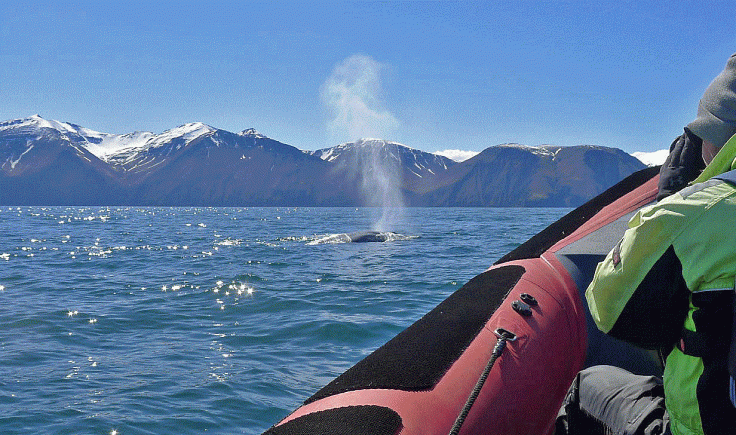
It’s the first calm and sunny day we’ve had. Which in itself is wonderful. But it’s all the more so because we will be speeding around the Skjalfandi Bay for 2.5 hours in a powerboat chasing whales.
The brochure says the 12-passenger Zodiac RIB boats are ‘faster than the wind’. Capable of reaching 65 km/h (40 mph), this nimble craft can catch up to a whale swimming at 20-30 km/h and maneuver close enough to get us the best photos from sea level.
Within the first hour, we see a Humpback whale (16 m long) and a no-name-yet hybrid whale, which is a cross between a Fin whale (21 m) and a Blue whale. For the last hour we follow two Blue whales, the largest mammal, averaging 30 m (80 ft) in length. At 200 tons, it’s too big to breach. But our captain spots one blowing and the chase begins.
At one point, the captain tells our guide that his radar indicates a long dark mass under the boat. It’s the Blue whale that submerged while we were chasing it, and I have heart-racing visions of it surfacing while still under us throwing us all into the freezing Arctic water. But it surfaces about 20-30 ft away, glides and dives again, leaving a smooth 20-ft long footprint on the surface of the water.
Clowns of the Sea
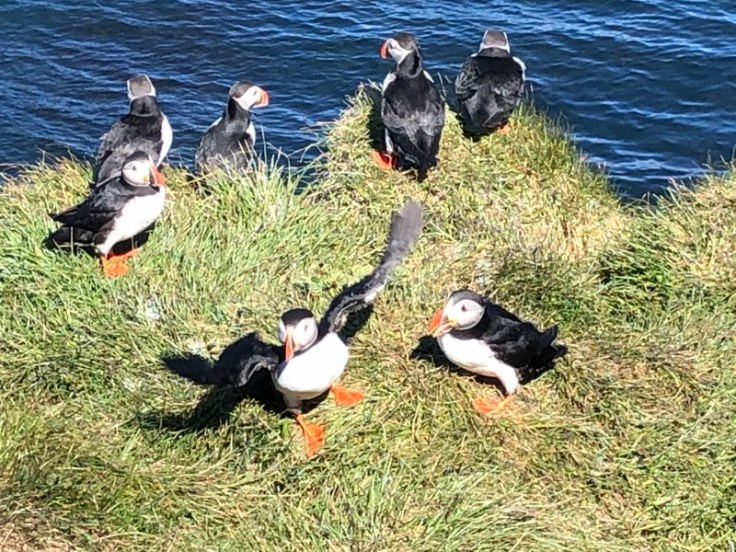
Egilsstadir is our last stop in East Iceland and the landscape changes once again from an arctic desert to the arctic woodlands. It’s only here, in the forested regions of East Iceland, that tundra reindeer live.
We drive north up the highway and meander our way up and down the jagged coastal fjords passing by small fishing villages to Borgarfjordur Eystri, and a marina at Halfnarholmi that has a colony of 10,000 puffins that nest here on the cliffs every summer.
Puffins are often called sea parrots or clown of the ocean for their colorful beaks and feet.
Puffin colonies can be found across Iceland, but here on the remote Eastern shores, there are fewer visitors and the wooden platforms and stairs allow us to get very close to the little birds.

Flying back to Reykevik across the Interior under cloudy skies we can only see part of Vatnajokull, the island’s highest peak and largest ice cap glacier, with 30 glaciers flowing from it. It was here, in 2011, that one of the volcanos erupted shutting down air travel for days.
Iceland is truly an island of unspoiled beauty and timeless majesty. And when you travel its roads, you travel through time, from its explosive formation 20 million years ago and the widening Mid-Atlantic Ridge, to the Nordic settlers who brought horses and formed the world’s oldest parliament 1,000 years ago, to the modern harnessing of geothermal energy to heat homes and city streets and sidewalks.

Hi Dawna…I enjoyed your exhilarating article! If you want more Iceland, you may want to check out the Netflix series “Trapped.” Happy travels! Mary Anne G.
LikeLike
Hi Dawna,
I was blown away by blog. What a fabulous trip you and Peter had. Thank you so much for sharing your adventure.
See you soon.
Fran
>
LikeLike
Thank you. So happy to be back.
LikeLike